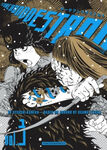Takeshi Murata
1 item found:

Gary Panter, Dash Shaw, Takeshi Murata, Robert Beatty, Sammy Harkham, Ben Jones, Anya Davidson, Chris Cilla, Kevin Huizenga, Gabrielle Bell, Johnny Ryan, Time Hensley, Leon Sadler, Frank Santoro, Ian Svenonius
retail price - $32.95
copacetic price $29.75
<<•>> edited by Sammy Harkham <<•>> Starting out way back in 2000 as a plain ol' self-published, black and white comic book (copies of which have recently been unearthed and are now once again being offered for sale; see below), Sammy Harkham's Kramers Ergot has been through some serious changes over the years. In 2003, when Sammy went for broke (literally) and switched to a massive full-color book format with the fourth issue, Kramers was transformed from a simple comic book to a synecdoche/catch phrase for the exploding art comics scene. The subsequent two issues followed suit and were published by art house publisher, Gingko Press. Then, with the seventh issue the stakes were raised again with the gigantic, full-blown, original-old-school Sunday page size – a whoppin'' 16" x 21" – full color, hardcover published by Buenaventura Press that knocked people's socks off the world over; not least folks here in Pittsburgh, where we hosted the Kramers Tour at The BrilloBox to much acclaim. Now, with the eighth issue, Kramers is being published by our pals at PictureBox and has entered yet another phase. This time out – perhaps in keeping with its maturation – Kramers takes the form of an unassuming standard size hardcover sporting a tan cloth cover of deceptively straightforward design by Robert Beatty; one which nonetheless provides both visual and tactile pleasure to the reader and hints at what is to come, which is another all-star anthology featuring some of today's top cartoonists working in an environment where they feel comfortable taking risks. An essay by Ian Svenonius, "Notes on Camp, Part 2" sets the tone with a hyperbolic sequel to Susan Sontag's famous essay, in which Svevonius traces a lineage for pop, camp and comics that centers on Warhol and goes back through to the Roman Empire. Then we are treated to a brand new Jimbo adventure by Gary Panter followed by new stories by C.F., Kevin Huizenga (who redraws the story "The Half Men" from the classic ACG series of the 1950s & '60s, Mysteries of Unexplained Worlds), Gabrielle Bell, Johnny Ryan, Time Hensley, Leon Sadler, Chris Cilla, Anya Davidson, Ben Jones and Sammy Harkham, himself. The clear standout of Kramers Ergot 8 is the collaboration between Dash Shaw and Frank Santoro, "Childhood Predators." This sixteen page story is a masterpiece of layout which was consciously composed as a series of eight two-page spreads by someone who really knows what they're doing. Santoro displays his mastery of the medium by employing a host of techniques and methods to deliver a highly textured, subtly nuanced, and deeply felt look at an emotionally complex and politically fraught scenario that will amply reward repeated readings. In addition to the comics, there are a pair of art portfolios featuring Robert Beatty's "retro-future" airbrush art, as well as a series of freakishly photorealistic digital artworks by Takeshi Murata, all of which are reproduced on bright glossy stock, in contrast to the flat off-white stock of the comics work. The 40-page dose of Oh, Wicked Wanda! comics that closes out this issue is also printed on glossy stock to mimic its original appearance in the pages of Penthouse Magazine back in the 1970s. Oh, Wicked Wanda was created by the British artist and writer duo of Ron Embleton and Frederic Mullalley as Penthouse's answer to Kurtzman and Elder's Little Annie Fannie, which ran in Playboy Magazine. As with everything Penthouse, it is the same as Playboy, only more so; and in this case, the humor is decidedly British (as was Penthouse) with its international settings and casual conflation of kinky sex with Nazis. We'd be curious to learn why the largest hunk of this issue of Kramers was devoted to these comics, so we hope Harkham will go on record as to his rationale and motivation here. Regardless of what they may be, Kramers remains in the vanguard of contemporary comics and is indispensable reading for anyone who likes their comics challenging.
Search Copacetic
Just in:










